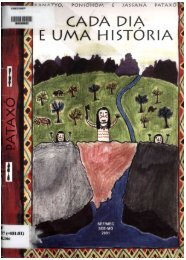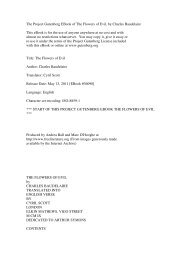A History of English Literature
A History of English Literature
A History of English Literature
Create successful ePaper yourself
Turn your PDF publications into a flip-book with our unique Google optimized e-Paper software.
just to the north <strong>of</strong> the 'city,' only a few minutes' walk from the center<br />
<strong>of</strong> population. His example was soon followed by other managers, though the<br />
favorite place for the theaters soon came to be the 'Bankside,' the region<br />
in Southwark just across the Thames from the 'city' where Chaucer's Tabard<br />
Inn had stood and where pits for bear-baiting and cock-fighting had long<br />
flourished.<br />
The structure <strong>of</strong> the Elizabethan theater was naturally imitated from its<br />
chief predecessor, the inn-yard. There, under the open sky, opposite the<br />
street entrance, the players had been accustomed to set up their stage.<br />
About it, on three sides, the ordinary part <strong>of</strong> the audience had stood<br />
during the performance, while the inn-guests and persons able to pay a<br />
fixed price had sat in the open galleries which lined the building and ran<br />
all around the yard. In the theaters, therefore, at first generally<br />
square-built or octagonal, the stage projected from the rear wall well<br />
toward the center <strong>of</strong> an unro<strong>of</strong>ed pit (the present-day 'orchestra'), where,<br />
still on three sides <strong>of</strong> the stage, the common people, admitted for sixpence<br />
or less, stood and jostled each other, either going home when it rained or<br />
staying and getting wet as the degree <strong>of</strong> their interest in the play might<br />
determine. The enveloping building proper was occupied with tiers <strong>of</strong><br />
galleries, generally two or three in number, provided with seats; and here,<br />
<strong>of</strong> course, sat the people <strong>of</strong> means, the women avoiding embarrassment and<br />
annoyance only by being always masked. Behind the unprotected front part <strong>of</strong><br />
the stage the middle part was covered by a lean-to ro<strong>of</strong> sloping down from<br />
the rear wall <strong>of</strong> the building and supported by two pillars standing on the<br />
stage. This ro<strong>of</strong> concealed a l<strong>of</strong>t, from which gods and goddesses or any<br />
appropriate properties could be let down by mechanical devices. Still<br />
farther back, under the galleries, was the 'rear-stage,' which could be<br />
used to represent inner rooms; and that part <strong>of</strong> the lower gallery<br />
immediately above it was generally appropriated as a part <strong>of</strong> the stage,<br />
representing such places as city walls or the second stories <strong>of</strong> houses. The<br />
musicians' place was also just beside in the gallery.<br />
The stage, therefore, was a 'platform stage,' seen by the audience from<br />
almost all sides, not, as in our own time, a 'picture-stage,' with its<br />
scenes viewed through a single large frame. This arrangement made<br />
impossible any front curtain, though a curtain was generally hung before<br />
the rear stage, from the floor <strong>of</strong> the gallery. Hence the changes between<br />
scenes must generally be made in full view <strong>of</strong> the audience, and instead <strong>of</strong><br />
ending the scenes with striking situations the dramatists must arrange for<br />
a withdrawal <strong>of</strong> the actors, only avoiding if possible the effect <strong>of</strong> a mere<br />
anti-climax. Dead bodies must either get up and walk away in plain sight or<br />
be carried <strong>of</strong>f, either by stage hands, or, as part <strong>of</strong> the action, by other<br />
characters in the play. This latter device was sometimes adopted at<br />
considerable violence to probability, as when Shakspere makes Falstaff bear<br />
away Hotspur, and Hamlet, Polonius. Likewise, while the medieval habit <strong>of</strong><br />
elaborate costuming was continued, there was every reason for adhering to<br />
the medieval simplicity <strong>of</strong> scenery. A single potted tree might symbolize a<br />
forest, and houses and caverns, with a great deal else, might be left to<br />
the imagination <strong>of</strong> the audience. In no respect, indeed, was realism <strong>of</strong><br />
setting an important concern <strong>of</strong> either dramatist or audience; in many<br />
cases, evidently, neither <strong>of</strong> them cared to think <strong>of</strong> a scene as located in<br />
any precise spot; hence the anxious effort <strong>of</strong> Shakspere's editors on this<br />
point is beside the mark. This nonchalance made for easy transition from<br />
one place to another, and the whole simplicity <strong>of</strong> staging had the important<br />
advantage <strong>of</strong> allowing the audience to center their attention on the play<br />
rather than on the accompaniments. On the rear-stage, however, behind the<br />
curtain, more elaborate scenery might be placed, and Elizabethan plays,<br />
like those <strong>of</strong> our own day, seem sometimes to have 'alternation scenes,'















